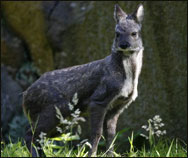 Khangchendzonga National Park, situated in North Sikkim bordering Nepal,
covers an area of 850 sq. km. and was set up on August 26, 1977. The area
of the park, named as a Biosphere reserve with an elevation ranging from
1830m to over 8550m, is enclosed by some impressive mountain peaks and
glaciers on all but its eastern side. On the western border, lies the
Khanchenjunga, one of the highest mountain peaks towering above virtually
undisturbed fine forest cover. The peaks and glaciers on the northern
side include the Nepal, Talung, Tent peaks and the Zemo (longest) and
Simyo glaciers and other peaks like Pandim, Narshing, Siniolchu etc in
other directions.
Khangchendzonga National Park, situated in North Sikkim bordering Nepal,
covers an area of 850 sq. km. and was set up on August 26, 1977. The area
of the park, named as a Biosphere reserve with an elevation ranging from
1830m to over 8550m, is enclosed by some impressive mountain peaks and
glaciers on all but its eastern side. On the western border, lies the
Khanchenjunga, one of the highest mountain peaks towering above virtually
undisturbed fine forest cover. The peaks and glaciers on the northern
side include the Nepal, Talung, Tent peaks and the Zemo (longest) and
Simyo glaciers and other peaks like Pandim, Narshing, Siniolchu etc in
other directions.
The park with its continuous tract of mountains, green
forests, flowering meadows and streams in its primitive wilderness attract
many nature and adventure lovers.
The lush vegetation include Temperate broad leaved forests
dominated by oaks, mixed Coniferous forests with fir, birch, maple, willow
etc and alpine grasses and shrubs at higher altitudes along with many
medicinal plants and herbs.
The fauna of the park are clouded leopard, snow leopard,
wild dog, thar, sloth bear, civet, Himalayan black bear, red panda, Tibetan
wild ass, blue sheep, serow, goral, takin, musk deer and reptiles like
rat snake and Russels viper etc. Among the avifauna of the state which
consist of almost 550 species of birds many are to be found in abundance
in the park like Blood Pheasants, Satyr Tragopan, Osprey, Himalayn griffon,
Lammergeier, tragopan pheasant, green pigeon, Tibetan snow cock, Snow
pigeon, Impeyan phesants, Asian emerald cookoo, Sunbirds & eagles.
There are a few Lepcha tribal settlements inside the park.
April to May and August to October are the best months
for visiting the park. Snowfall is heavy in winter and monsoon showers
exist from May to mid October. To enter the National Park and
Sanctuaries, permission of the State Chief Wildlife is required and this
can be obtained on payment of entry fees.
Trekking
Yuksom (145km from the capital Gangtok) in West Sikkim is a starting
point for trekkers and mountaineers. They can get a permit from the Wildlife
Education and Interpretation centre at Yuksom or from the checkpost. State
Tourism Department and other travel agents organise treks to Dzongri (4050
m), a two day trek from Yuksom. The trek routes are (a) Yuksom - Tshoka
- Dzongri (b) Bakim - Dzongri - Thangshing - Samuteng - Goechala
(c) Dzongri Base Camp - Rathong - Khangerteng (d) Thangshing - Lam
Pokhari - Kasturi Orar - Lapdong - Tashiding (Road Head). Lachen a village
in North Sikkim is another starting point for a trek to Green lake which
takes four to six days to reach through treacherous routes. Foreign nationals
would require a restricted area permit from the Ministry of Home Affairs,
Government of India, Delhi to visit areas in this part of the region.
Indian nationals are required to obtain an Inner-Line Permit from the
State Home Department. Permission of the State Chief Wildlife Warden is
also mandatory. The routes are (a) Lucanes Jakchen-Yabuk-Rest Camp (Marco
Polo Camp) - Green Lake (b) Lachen-Thasngu (13,695') Muguthang (16,000')
- Thay La (17,000') - Khyoksa La (18,000') Rest Camp-Green Lake. Muguthang
holds the famous annual Yak race.
|

